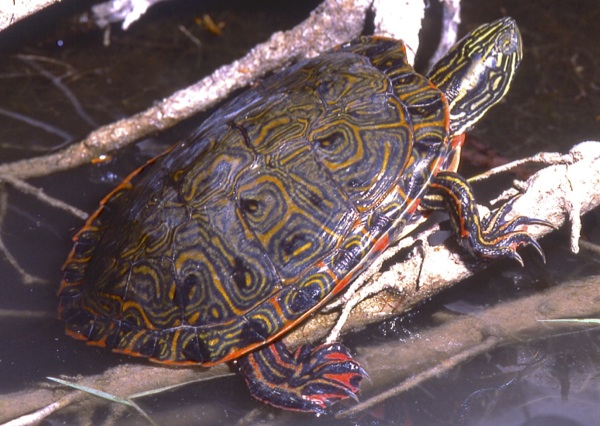Pseudemys gorzugi, 100
Pseudemys gorzugi Ward 1984 –
Rio Grande Cooter, Western River Cooter,
Tortuga de Oreja Amarilla, Jicotéa del Río Bravo
Leland J.S. Pierce1, James N. Stuart1, Joseph P. Ward2,
and Charles W. Painter1,3
1New Mexico Department of Game and Fish, P.O. Box 25112, Santa Fe, New Mexico 87504 USA
[[email protected], [email protected]];
26899 S. Highway A1A, Melbourne Beach, Florida 32951 USA [[email protected]];
3Deceased
Summary. – The Rio Grande Cooter, Pseudemys gorzugi (Family Emydidae), is a medium-sized to large (carapace length to at least 372 mm) riverine turtle that is endemic to the Rio Grande (= Río Bravo del Norte) drainage basin of the southwestern United States and northeastern Mexico. The species is monotypic and genetically distinct from congeners. Relatively little research has focused on the natural history and population status of this species anywhere in its range and it is among the least-studied turtles in North America. Degradation and fragmentation of this species’ aquatic habitat and over-collection for the pet trade likely pose the greatest threats to its survival. Protective measures currently in place for this turtle in the United States and Mexico are very limited to non-existent.
Distribution. – Mexico, USA. Distributed along the Rio Grande (= Río Bravo del Norte) from the Big Bend region to the Gulf of Mexico; the Pecos River from southeastern New Mexico to its confluence with the Rio Grande, with an apparent gap from south of the New Mexico border to Independence Creek in Terrell County, Texas; and in tributary streams to these two rivers in northeastern Mexico (Coahuila, Nuevo Leon, Tamaulipas, and possibly Chihuahua) and the southwestern United States (New Mexico and Texas).
Synonymy. – Pseudemys concinna gorzugi Ward 1984, Pseudemys gorzugi.
Subspecies. – None.
Status. – IUCN 2016 Red List: Near Threatened (NT, assessed 2010); CITES: Not Listed; USA ESA: Not Listed; Mexico SEMARNAT: Threatened; New Mexico: State Threatened, Species of Greatest Conservation Need; Texas: Not Listed, Species of Greatest Conservation Need.
Citation:
Pierce, L.J.S., Stuart, J.N., Ward, J.P., and Painter, C.W. 2016. Pseudemys gorzugi Ward 1984 – Rio Grande Cooter, Western River Cooter, Tortuga de Oreja Amarilla, Jicotéa del Río Bravo. In: Rhodin, A.G.J., Iverson, J.B., van Dijk, P.P., Saumure, R.A., Buhlmann, K.A., Pritchard, P.C.H., and Mittermeier, R.A. (Eds.). Conservation Biology of Freshwater Turtles and Tortoises: A Compilation Project of the IUCN/SSC Tortoise and Freshwater Turtle Specialist Group. Chelonian Research Monographs 5(9):100.1–12. doi: 10.3854/crm.5.100.gorzugi.v1.2016; iucn-tftsg.org/cbftt/.
(Adobe Acrobat 6.0 or later required)

Pseudemys gorzugi, adult, from Black River, Eddy County, New Mexico, USA.
Photo by Charles W. Painter.
Distribution:

Historic distribution of Pseudemys gorzugi in southwestern USA (New Mexico and Texas) and northeastern Mexico (Coahuila, Nuevo Leon, Tamaulipas, and possibly Chihuahua). Yellow dots = museum and literature occurrence records of native populations based on Iverson (1992), plus more recent and authors’ data; orange dots = introduced or misidentified specimens; red shading = projected historic distribution. Distribution based on GIS-defined level 12 HUCs (hydrologic unit compartments) constructed around verified localities and then adding HUCs that connect known point localities in the same watershed or physiographic region, and similar habitats and elevations as verified HUCs (Buhlmann et al. 2009; TTWG 2014), and adjusted based on authors’ subsequent data.








